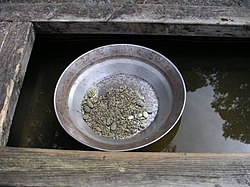Gold panning: Difference between revisions
m Reverted edits by 211.28.55.210 (talk) to last revision by Volcanoguy (HG) |
→Pan: unsourced |
||
| Line 9: | Line 9: | ||
==Equipment== |
==Equipment== |
||
===Pan=== |
===Pan=== |
||
Pans are measured by their diameter in inches. Common sizes of gold pans today ranges between 10-17 inches, with '''14 inches''' being the most used size. Pans are manufactured in both metal and high impact plastic. Heavy gauge steel pans are traditional. Steel pans are heavier and stronger than plastic pans. Some are made of lightweight alloys for structural stability. Plastic gold pans resist rust, acid and corrosion, and most are designed with moulded riffles along one side of the pan. Of the plastic gold pans, green and blue ones are usually preferred among prospectors, as both the gold and the black sand stands out in the bottom of the pan |
Pans are measured by their diameter in inches. Common sizes of gold pans today ranges between 10-17 inches, with '''14 inches''' being the most used size. Pans are manufactured in both metal and high impact plastic. Heavy gauge steel pans are traditional. Steel pans are heavier and stronger than plastic pans. Some are made of lightweight alloys for structural stability. Plastic gold pans resist rust, acid and corrosion, and most are designed with moulded riffles along one side of the pan. Of the plastic gold pans, green and blue ones are usually preferred among prospectors, as both the gold and the black sand stands out in the bottom of the pan. |
||
===Pan Designs=== |
===Pan Designs=== |
||
Revision as of 23:39, 23 May 2012

Gold panning, or simply panning, is a form of placer and traditional mining that extracts gold from a placer deposit using a pan. The process is one of the simplest ways to extract gold, and is popular with geology enthusiasts because of its cheap cost and the relatively simple and easy process involved. It is the oldest method of mining gold.[1] The first recorded instances of placer mining are from ancient Rome, where gold and other precious metals were extracted from streams and mountainsides using sluices and panning.[2]
Process
Gold panning is a very simple process. Once a suitable placer deposit is located, some gravel from it is scooped into a pan, where it is then gently agitated in water and the gold sinks to the bottom of the pan. Materials with a low specific gravity are allowed to spill out of the pan, whereas materials with a high specific gravity sink to the bottom of the sediment during agitation and remain within the pan for examination and collection by the gold panner. These dense materials usually consist primarily of a black, magnetite sand with whatever gemstones or metal dust that may be found in the deposit that is used for source material.
Gold panning usually turns up only gold dust that is usually collected as a souvenir. Nuggets and considerable amounts of dust are occasionally found, but panning mining is not generally lucrative; panning for gold can be used to locate the larger parent veins of gold that most placer deposits originate from.
Equipment
Pan
Pans are measured by their diameter in inches. Common sizes of gold pans today ranges between 10-17 inches, with 14 inches being the most used size. Pans are manufactured in both metal and high impact plastic. Heavy gauge steel pans are traditional. Steel pans are heavier and stronger than plastic pans. Some are made of lightweight alloys for structural stability. Plastic gold pans resist rust, acid and corrosion, and most are designed with moulded riffles along one side of the pan. Of the plastic gold pans, green and blue ones are usually preferred among prospectors, as both the gold and the black sand stands out in the bottom of the pan.
Pan Designs
Gold pans of various designs have been developed over the years,[3] the common features being a means for trapping the heavy materials during agitation, or for easily removing them at the end of the process. Some are intended for use with mercury, include screens, sharp corners for breaking ice, are non-round, or are even designed for use "with or without water". Edward Otho Cresap Ord, II, a former Army officer and co-owner of several mines, patented several pan designs including designs for use with mercury or dry.[3]
See also
- Placer mining
- C. J. Stevens, author of The Next Bend in the River: Gold Mining in Maine[4][5][6][7] and Memoirs of a Maine Gold Hunter[8]
References
- ^ History of Gold, 2007-10-18, retrieved 2009-12-14
- ^ Lynn Cohen Duncan (1999-12-09), Roman Deep-vein Mining, retrieved 2009-12-14
- ^ a b Various. "GOLD PANS of every shape". ECO-MINEX INTERNATIONAL LTD. Retrieved August 30, 2010. Cite error: The named reference "Special2" was defined multiple times with different content (see the help page).
- ^ "C.J. Stevens' New Book on Nearly Two Centuries of Maine Mining a Real Gem". Kennebec Journal and Morning Sentinel. September 25, 1994. Retrieved July 9, 2010.
- ^ Brenda Seekins (September 2, 1995). "Nugget of truth in 'them thar Maine hills'; Persistence can pay off when panning for golf in the Swift River valley". Bangor Daily News. Retrieved July 9, 2010.
- ^ Jim Buchta (December 22, 1996). "Farmington, Maine; Bustling retreat nestled in forest". Star Tribune (Minneapolis, MN). Retrieved July 9, 2010.
- ^ "TV Show to Focus on Hedgehog Hill", Sun Journal, October 27, 1989. Retrieved July 10, 2010.
- ^ Gary Shapiro (July 14, 2006). "Of Treasure & Trash". The New York Sun. Retrieved July 9, 2010.
